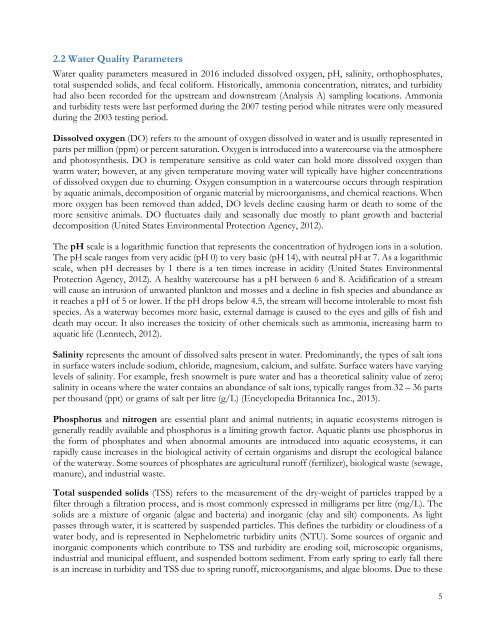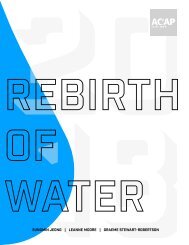Rebirth of Water Report 2016-2017
Marsh Creek, which is the largest watershed in greater Saint John, has been the recipient of centuries of untreated municipal wastewater deposition. Offensive odours, unsightly sanitary products and the threat posed by various human pathogens, resulting largely from the ~50 sewage outfalls in the lower reaches of Marsh Creek and the Saint John Harbour, have caused most residents to abandon the wellness of the watercourse. ACAP Saint John, a community-based ENGO and champion of the Harbour Cleanup project, has been conducting water quality monitoring and fish community surveys in the watershed since 1993 with the view towards someday restoring the ecological integrity of this forgotten natural asset.
Marsh Creek, which is the largest watershed in greater Saint John, has been the recipient of centuries of untreated municipal wastewater deposition. Offensive odours, unsightly sanitary products and the threat posed by various human pathogens, resulting largely from the ~50 sewage outfalls in the lower reaches of Marsh Creek and the Saint John Harbour, have caused most residents to abandon the wellness of the watercourse. ACAP Saint John, a community-based ENGO and champion of the Harbour Cleanup project, has been conducting water quality monitoring and fish community surveys in the watershed since 1993 with the view towards someday restoring the ecological integrity of this forgotten natural asset.
Create successful ePaper yourself
Turn your PDF publications into a flip-book with our unique Google optimized e-Paper software.
2.2 <strong>Water</strong> Quality Parameters<br />
<strong>Water</strong> quality parameters measured in <strong>2016</strong> included dissolved oxygen, pH, salinity, orthophosphates,<br />
total suspended solids, and fecal coliform. Historically, ammonia concentration, nitrates, and turbidity<br />
had also been recorded for the upstream and downstream (Analysis A) sampling locations. Ammonia<br />
and turbidity tests were last performed during the 2007 testing period while nitrates were only measured<br />
during the 2003 testing period.<br />
Dissolved oxygen (DO) refers to the amount <strong>of</strong> oxygen dissolved in water and is usually represented in<br />
parts per million (ppm) or percent saturation. Oxygen is introduced into a watercourse via the atmosphere<br />
and photosynthesis. DO is temperature sensitive as cold water can hold more dissolved oxygen than<br />
warm water; however, at any given temperature moving water will typically have higher concentrations<br />
<strong>of</strong> dissolved oxygen due to churning. Oxygen consumption in a watercourse occurs through respiration<br />
by aquatic animals, decomposition <strong>of</strong> organic material by microorganisms, and chemical reactions. When<br />
more oxygen has been removed than added, DO levels decline causing harm or death to some <strong>of</strong> the<br />
more sensitive animals. DO fluctuates daily and seasonally due mostly to plant growth and bacterial<br />
decomposition (United States Environmental Protection Agency, 2012).<br />
The pH scale is a logarithmic function that represents the concentration <strong>of</strong> hydrogen ions in a solution.<br />
The pH scale ranges from very acidic (pH 0) to very basic (pH 14), with neutral pH at 7. As a logarithmic<br />
scale, when pH decreases by 1 there is a ten times increase in acidity (United States Environmental<br />
Protection Agency, 2012). A healthy watercourse has a pH between 6 and 8. Acidification <strong>of</strong> a stream<br />
will cause an intrusion <strong>of</strong> unwanted plankton and mosses and a decline in fish species and abundance as<br />
it reaches a pH <strong>of</strong> 5 or lower. If the pH drops below 4.5, the stream will become intolerable to most fish<br />
species. As a waterway becomes more basic, external damage is caused to the eyes and gills <strong>of</strong> fish and<br />
death may occur. It also increases the toxicity <strong>of</strong> other chemicals such as ammonia, increasing harm to<br />
aquatic life (Lenntech, 2012).<br />
Salinity represents the amount <strong>of</strong> dissolved salts present in water. Predominantly, the types <strong>of</strong> salt ions<br />
in surface waters include sodium, chloride, magnesium, calcium, and sulfate. Surface waters have varying<br />
levels <strong>of</strong> salinity. For example, fresh snowmelt is pure water and has a theoretical salinity value <strong>of</strong> zero;<br />
salinity in oceans where the water contains an abundance <strong>of</strong> salt ions, typically ranges from 32 – 36 parts<br />
per thousand (ppt) or grams <strong>of</strong> salt per litre (g/L) (Encyclopedia Britannica Inc., 2013).<br />
Phosphorus and nitrogen are essential plant and animal nutrients; in aquatic ecosystems nitrogen is<br />
generally readily available and phosphorus is a limiting growth factor. Aquatic plants use phosphorus in<br />
the form <strong>of</strong> phosphates and when abnormal amounts are introduced into aquatic ecosystems, it can<br />
rapidly cause increases in the biological activity <strong>of</strong> certain organisms and disrupt the ecological balance<br />
<strong>of</strong> the waterway. Some sources <strong>of</strong> phosphates are agricultural run<strong>of</strong>f (fertilizer), biological waste (sewage,<br />
manure), and industrial waste.<br />
Total suspended solids (TSS) refers to the measurement <strong>of</strong> the dry-weight <strong>of</strong> particles trapped by a<br />
filter through a filtration process, and is most commonly expressed in milligrams per litre (mg/L). The<br />
solids are a mixture <strong>of</strong> organic (algae and bacteria) and inorganic (clay and silt) components. As light<br />
passes through water, it is scattered by suspended particles. This defines the turbidity or cloudiness <strong>of</strong> a<br />
water body, and is represented in Nephelometric turbidity units (NTU). Some sources <strong>of</strong> organic and<br />
inorganic components which contribute to TSS and turbidity are eroding soil, microscopic organisms,<br />
industrial and municipal effluent, and suspended bottom sediment. From early spring to early fall there<br />
is an increase in turbidity and TSS due to spring run<strong>of</strong>f, microorganisms, and algae blooms. Due to these<br />
5


















